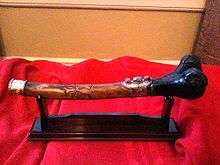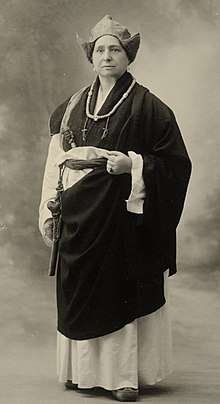Kangling
Kangling (Tibetan: རྐང་གླིང་།, Wylie: rkang-gling ), literally translated as "leg" (kang) "flute" (ling), is the Tibetan name for a trumpet or horn made out of a human femur, used in Tibetan Buddhism for various chöd rituals as well as funerals performed by a chöpa. The femur of a criminal or a person who died a violent death is preferred.[1] Alternatively, the femur of a respected teacher may be used.[2] The kangling may also be made out of wood.


The kangling should only be used in chöd rituals performed outdoors with the chöd damaru and bell.[1] In Tantric chöd practice, the practitioner, motivated by compassion, plays the kangling as a gesture of fearlessness, to summon hungry spirits and demons so that she or he may satisfy their hunger and thereby relieve their sufferings. It is also played as a way of "cutting off of the ego."

A minor figure from Katok Monastery, the First Chonyi Gyatso, Chopa Lugu (17th - mid-18th century), is remembered for his "nightly bellowing of bone-trumpet [kangling] and shouting of phet" on pilgrimage, much to the irritation of the business traveler who accompanied him. Chopa Lugu became renowned as "The Chod Yogi Who Split a Cliff in China (rgya nag brag bcad gcod pa)."[3]
See also
References
- O.C. Handa (2005). Buddhist Monasteries of Himachal. Indus Publishing Company. p. 320. ISBN 81-7387-170-1.
- Andrea Loseries-Leick (2008). Tibetan Mahayoga Tantra: An Ethno Historical Study of Skulls, Bones and Relics. B.R. Pub. Corp. p. 225.
- Chhosphel, Samten (December 2011). "The First Chonyi Gyatso, Chopa Lugu". The Treasury of Lives: Biographies of Himalayan Religious Masters. Retrieved 8 October 2013.